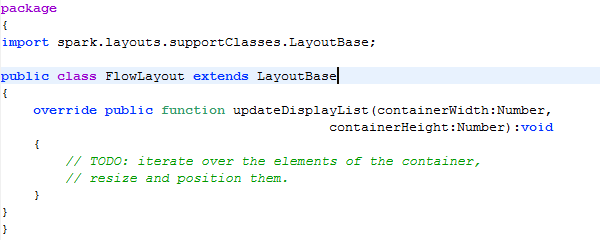
These classes inherit from QLayout, which in turn derives from QObject (not QWidget). The easiest way to give your widgets a good layout is to use the built-in layout managers: QHBoxLayout, QVBoxLayout, QGridLayout, and QFormLayout. Horizontal, Vertical, Grid, and Form Layouts Stack of widgets where only one widget is visible at a time Layout attribute describing horizontal and vertical resizing policy Layout where one can anchor widgets together in Graphics View Represents an anchor between two items in a QGraphicsAnchorLayout Manages forms of input widgets and their associated labels Lines up child widgets horizontally or verticallyĬontainer to organize groups of button widgets Qt Designer is useful to use when experimenting with the design of a form since it avoids the compile, link and run cycle usually involved in user interface development.
Make flowlayout but fill vertically code#
The code generated for forms created using Qt Designer also uses the layout classes. Qt's layout classes were designed for hand-written C++ code, allowing measurements to be specified in pixels for simplicity, so they are easy to understand and use. Font size, text or other contents of child widgets.Automatic updates when contents change:.When a layout is set on a widget in this way, it takes charge of the following tasks:

The QWidget::setLayout() function applies a layout to a widget. These layouts automatically position and resize widgets when the amount of space available for them changes, ensuring that they are consistently arranged and that the user interface as a whole remains usable.Īll QWidget subclasses can use layouts to manage their children. Qt includes a set of layout management classes that are used to describe how widgets are laid out in an application's user interface. Me.flowLayoutPanel1 = New Qt layout system provides a simple and powerful way of automatically arranging child widgets within a widget to ensure that they make good use of the available space. If disposing AndAlso (components IsNot Nothing) Then Protected Overrides Sub Dispose(disposing As Boolean) Private flowLayoutPanel1 As FlowLayoutPanel Private flowLayoutPanel3 As FlowLayoutPanel Protected override void Dispose(bool disposing)

Private FlowLayoutPanel flowLayoutPanel1 Private FlowLayoutPanel flowLayoutPanel3 The following code example demonstrates various Anchor property values for a Button control in a FlowLayoutPanel control. The following illustration shows four buttons that are anchored and docked relative to the blue button in a FlowLayoutPanel.

The FlowLayoutPanel control calculates the height of an implied row from the tallest child control in the row, and all docked or anchored child controls in this row are aligned or sized to fit the implied row. The behavior works in a similar way for horizontal flow directions. All other controls in this column with Anchor or Dock properties are aligned or stretched to fit this implied column. This is the general rule for anchoring and docking in the FlowLayoutPanel control: for vertical flow directions, the FlowLayoutPanel control calculates the width of an implied column from the widest child control in the column. It does not stretch across the width of the FlowLayoutPanel control. The second button assumes the same width as the first button.


 0 kommentar(er)
0 kommentar(er)
